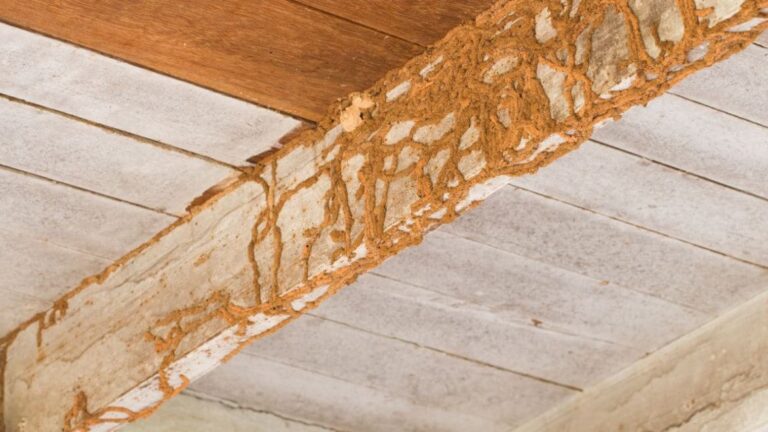When it comes to your building’s structure, termite damage and rotting wood can be incredibly harmful. But it can be challenging to tell what is actually happening because both types of wood decay have effects that look similar. It can be difficult to tell termite damage from wood rot when you first start looking for it. If you want to know how to distinguish termite damage and wood rot, please read this article carefully.
- What Is Termite Damage?
- What Is Wood Rot?
- Common Causes Of Termite Damage And Wood Rot
- How Can You Tell Termite Damage From Other Damage? Wood Rot?
- Which Is Worse: Wood Rot Or Termite Damage?
- Termite Damage Or Wood Rot: What Should You Do?
- How Do I Fix And Prevent Rotted Wood?
- Can Termite Damage Be Repaired?
What Is Termite Damage?
An example of an insect that colonizes widely is the termite. Despite the fact that there are numerous species throughout the United States (aside from Alaska), cellulose, a complex carbohydrate found in grass, leaves, and, most regrettably, wood, is the primary food source for termites.
Termites are one of the worst household pests, even though some species are subterranean and some prefer to live in damp, decaying wood. Termites are a year-round problem.
Since termites eat wood from the inside out, damage to a house is frequently not noticeable until it is severe. Termites tunnel through and bore into wood, giving the material a distinct maze-like appearance.
Other than this obvious evidence, the most conclusive signs are direct evidence of the colony themselves, such as: Clicking or chewing sounds in the walls, droppings (called frass), distinctive trails called “mud tubes” along the edges of your house or rooms and termites themselves—dead or alive.
Wood rot and other problems, like termite activity, frequently look alike. Buckling or swelling wood, the scent of mold, blistering, and signs of “water damage” can all be evidence of termites.
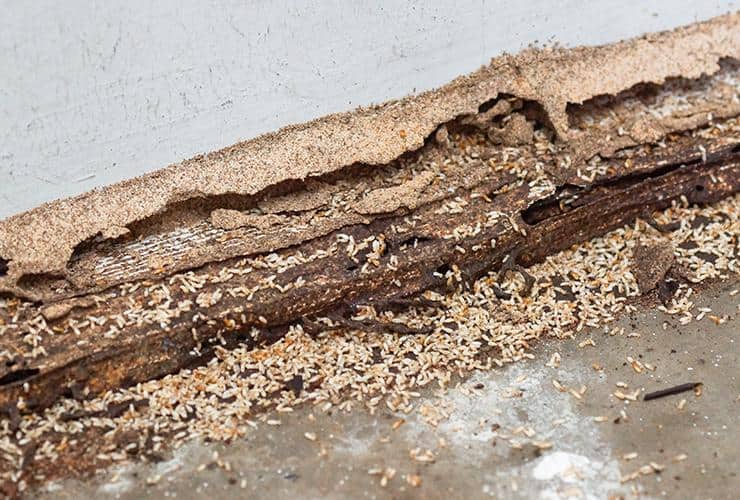
Generally speaking, it is safe to assume that the damage is severe by the time you can clearly see signs of termite activity. Since termites can quickly proliferate, it’s important to take preventative measures as soon as you suspect a colony—or even earlier if your neighbors report them.
What Is Wood Rot?
A fungus that breaks down wood and consumes cellulose and lignin is the source of both wet and dry wood rot. Although dry rot can also spread in dry lumber, wet rot is more frequently found in areas with high moisture content or water damage.
As soon as an infestation begins, it will quickly spread, making the wood weak and pliable. For this reason, a home inspector may be seen literally poking around a house’s eaves and trim.
Wood rot can also be distinguished by its distinct musty, fungal, and earthy smell, which gets stronger as the issue gets worse.
The affected wood may become discolored, crack, or splinter; as the cellulose decomposes, the wood will also start to shrink in size. In extreme cases, the spores and fungal growth may be visible, and the wood may crack and crumble when put under stress.
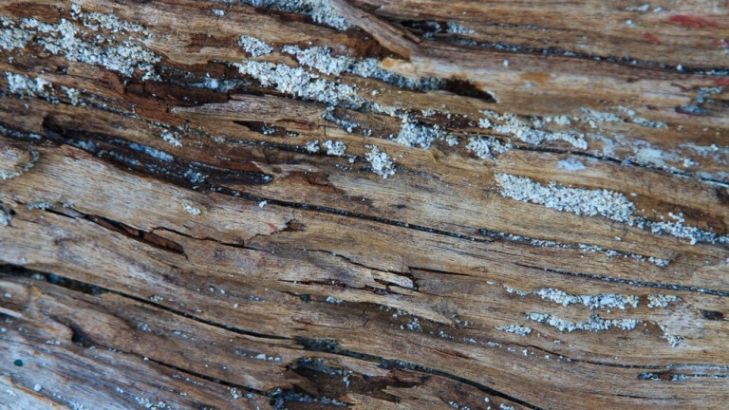
Although these can also be caused by a number of other problems, seemingly unimportant paint problems (such as bubbling, blistering, or flaking) may also be an indication of underlying wood rot.
Common Causes Of Termite Damage And Wood Rot
It’s time to look at what causes termite damage and wood rot now that you know how to recognize whether you have either of these problems. Both eventually result in the destruction of your wooden structures, but they do so for various reasons.
Causes Of Termite Damage
Wood that is suitable for termites’ living conditions is usually attractive to them. They like to eat wet wood, for one. You run a much higher risk of having termites wreak havoc if your home has damp walls or wet wood.
Additionally, termites prefer wood that is in close proximity to the house’s foundation. This is due to their ability to move through the ground and enter the wood to begin feasting.
Furthermore, termites can easily access the center of the wood through other cracks in walls and other structures, making them ideal for termites. Termites search for openings so they can get inside and start munching on your wooden structures.
Get your house routinely inspected for termite damage if you see cracks, wet wood, or if your foundation is made of wood. Even if an inspection reveals no termites present, using preventative treatments can help keep these pests at bay.
Causes Of Dry Wood Rot
Insufficient ventilation and humidity levels of 20 to 30 percent cause dry rot. As a result, dry rot fungi flourish in this environment. A few conditions necessary for the creation of dry rot include:
- Moisture
- Wood
- Oxygen
- Poor ventilation
- Dry rot spores
Homes that meet these requirements are always at risk for dry rot damage because the spores that cause the disease are constantly floating in the air. Unless there are ideal environmental conditions for their proliferation, dry rot spores don’t typically settle on wooden structures.
However, dry rot can quickly spread to other parts of the structure once it starts to eat away at the wood in your home. Because of this, it is crucial to treat it right away.
Cause Of Wet Wood Rot
Not all rots that affect wood are dry rot. Wet rot is another type of rot that can seriously harm the structure of your house or place of business.
Wood that is continually exposed to moisture will eventually rot. This may occur as a result of moisture leaking in from the outside of the building or water moistening the wood from within.
A few typical causes of wet rot are:
- Roof damage
- Plumbing system leaks
- Bath and shower trays
- Dampness penetrating the walls
- Condensation
- Blocked or leaky gutters
If these problems are not resolved quickly, dry rot may start to form and then spread throughout the house. The sooner the rot is treated, the less likely it is that you will continue to experience problems.
How Can You Tell Termite Damage From Other Damage? Wood Rot?
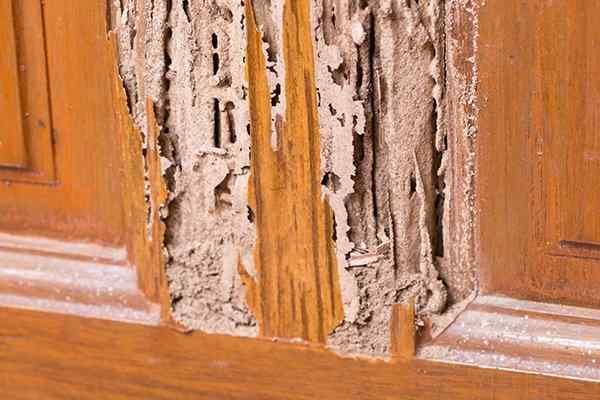
Knowing how to distinguish between termite damage and wood rot is the first step in determining whether you are dealing with one or the other. wood rot. Even though these two kinds of damage may appear similar, there are usually a few clues as to which one you have.
Termites Tend To Live In Wet Wood
The presence of moisture in the wood can be one of the first signs that termite damage is taking place as opposed to wood rot. Dry wood won’t typically be attacked by termites, whereas wet wood can start to rot.
As a result, there is a good chance that fungi are to blame if you find that dry wood has been damaged. A termite colony, however, may be indicated by wet wood that has damage.
Dry Rot Will Weaken The Wood
Weakening in dry wood is another difference to watch for. Fungi that are eating away at the dry wood may be to blame if you notice that your wood is weaker.
The wood will start to rot and lose its structure as a result of the fungi’s ravaging. Additionally, it frequently has a stringy texture. In the event that you spot these symptoms, termite damage is probably not the cause of the wood’s problems.
Termite Damage Occurs On The Inside
It’s a common misconception that termites begin by gnawing away at the wood’s exterior. In actuality, termites begin by devouring the interior of the wood before moving on to the exterior.
On the other hand, wood rot begins on the exterior of the wooden structure. In due course, the rot will penetrate deeper into the wood, destroying it from the inside out.
Which Is Worse: Wood Rot Or Termite Damage?
The structural integrity of your home can be severely harmed by both termite damage and wood rot. The two might even encourage one another, which is even worse. A termite colony may be drawn to a dry rot infestation because the softened wood makes the ideal food source and habitat for termites.
On the other hand, termite-ravaged wood leaves behind holes that are ideal for moisture to collect in and begin the process of wood rot.
Your home may have suffered minor to severe damage, necessitating the replacement of all damaged wood, depending on how long either situation goes unnoticed.
You must immediately get in touch with experts to assess and take care of any wood damage, no matter how minor, as both termites and wood rot spread quickly.
Termite Damage Or Wood Rot: What Should You Do?
Once you notice wood damage, you should generally hire a professional to conduct a thorough house inspection and assessment. This is crucial because termite damage and wood rot can coexist and because termites can easily go undetected.
You can start addressing the wood damage—and you should—once you’ve got a second or third opinion on its cause and extent.
You must first get in touch with a certified pest control company to completely eradicate the colony (or colonies) of termites. Insecticides, baits, traps, boric acid, and direct chemical application to specific areas of your home are just a few of the services they can provide.
While you can attempt to DIY this procedure, we do not advise it due to the chemicals used and the need to completely eradicate termites in order to avoid the possibility of a future infestation.
Before starting the repair procedure, wait for confirmation from the expert. The damaged wood can either be completely replaced or additional supports can be added where necessary.
Wherever and whenever possible, a licensed structural engineer should determine what repairs are sufficient.
When wood rot occurs, you can frequently make a DIY repair by removing the rot, treating the area with fungicide, and then filling the holes with epoxy resin. In the long run, replacing the wood entirely might be less time-consuming and more cost-effective.
This is especially true if you live in a region where moisture is a persistent problem because new lumber will be simpler to treat, safeguard, and maintain. Before making any repairs, keep in mind that the wood must completely dry.
How Do I Fix And Prevent Rotted Wood?
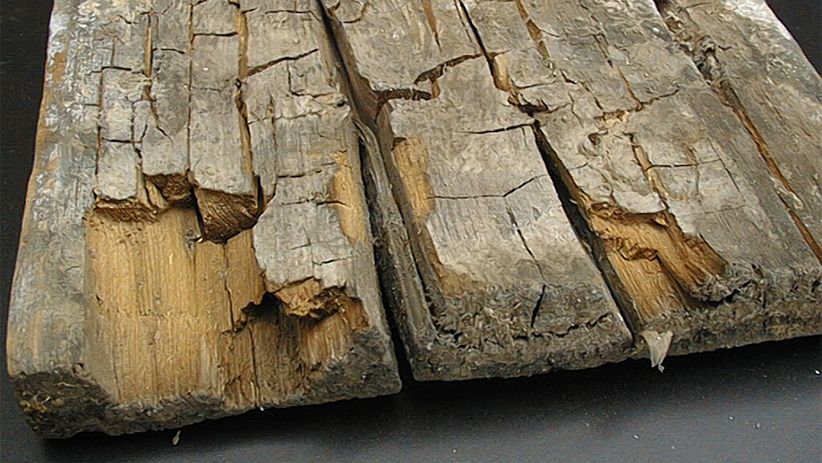
In softwood, extensive dry rot degradation is frequently irreversible. On the other hand, if wet rot is caught early enough, it can be fixed and restored. However, you can take action to stop wood rot.
Here are some tips for preventing wood rot in your home or apartment.
- Making the appropriate wood selection comes first. Mahogany, teak, and other species are highly rot-resistant woods. Pressure-treated wood is the best alternative if you cannot afford expensive hardwood.
- After that, stain the wood with the proper coating to protect it from moisture. You might need to use varnish, lacquer, or polyurethane coating, depending on the amount of moisture exposure and the use.
- Check for gaps, cracked caulks, and paint that has peeled off. Replace them with new caulk after removing the old ones. To fix peeling paint, sand the affected area with a sander, then repaint it.
- Keep water off the wood for as little time as possible. Sweep snow and water off the deck, patio, and other surfaces. Wipe the furniture to remove any moisture.
- Put in an exhaust fan in the bathroom and a hood in the kitchen to let the steamy air out.
- To lower the moisture levels inside, think about purchasing a dehumidifier.
- Finally, to stop the source of moisture from causing water damage, fix water leaks and clean waterways like gutters and kitchen sinks.
Can Termite Damage Be Repaired?
Yes, after the termites have been removed and the compromised wood removed. A specialist must examine this. This entails a thorough assessment of the condition of any remaining wood.
Usually, some reinforcement is needed for wood that can be repaired. This is why it is preferable to replace the damaged area.
Wood hardeners can be used to treat a termite infestation if the damage is limited to the structure’s surface. These wood-hardening substances repair any cracks, crevices, or other damage caused by termites.
Another solution is wood sealers, which kill termite colonies within a few days by cutting off their oxygen supply.
Consider a different, more intensive type of repair if the termite infestation is only moderately invasive. In this procedure, infected wood pieces are chipped away, and the surface is then smoothed off by sanding. When you buy wood fillers, they typically come with step-by-step instructions.
The next step is to add the filler to the area. These fixes are essential to halting the spread of the termites’ damage because if they are neglected for an extended period of time, the colonies will continue to infest your home and cause structural damage.
We advise consulting a professional when termites have caused structural damage to your home. Experts can remove the severely harmed wood, which may require cutting through plumbing and electrical lines inside the infestation area.
To make sure all termite colonies are eliminated, they will probably add wood sealants to the remaining buildings that surround the site. After that, they will rebuild that structure without using termites.

